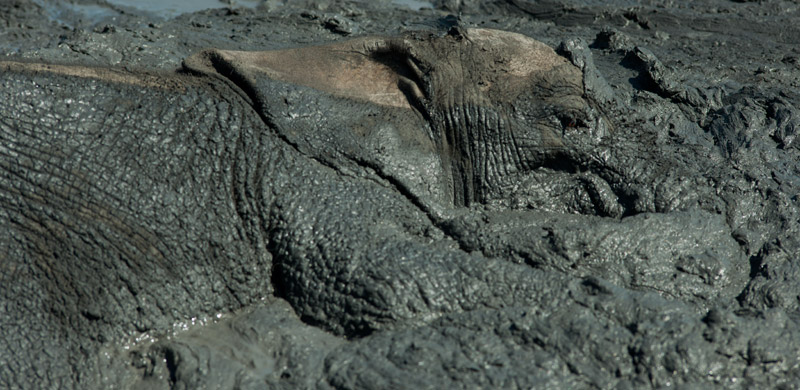Captured by the sludge
Once out of the woods, the young elephant immediately began to frolic around, and then, after drinking and spraying herself with mud, curiously went to lie next to her dying mother. She stayedthere all the night long, huddled, motionless. In the morning she was still there, alive, though hyenas had come around the camp during the night. Atthis time of year drought has killed so many elephants that plenty food is readily available for all carnivores. Strangely the elephants themselves, contrary to the belief that elephants help one another, started an assault on the dying mother,smashing her belly and split open her head. So badly was she injured that the Guides had to shoot her this morning after getting the approval the Park authorities. It is now necessary to pull his body away from the water hole. The little one is still alive, but there is serious doubt thatshe can survive alone as she is not weaned yet. This is just one of many similar stories at this time of year. The Zambezi Traveller reports in its latest issue, an similar incidentexperienced by aGuidenear a water hole. He attests to the almost criminal rage with which elephants attacked mercilessly, for a long time on one of their fellow pachyderms who was wounded and lying on the ground eventually killing him by spearing him with their tusks. The guide concludes his testimony by sayingthat such behaviour is an example of the “struggle for survival” in stressful times. We could conclude and say that nature is “bad”, and we would show a lot of ignorance to say that it is “good”, but,if nature is generally selfish and opportunistic, it can also show cooperation and magnanimity.
To be continued…
Prisonniers des boues
Une fois tiré d’affaire, le petit s’est mis à gambader tout de suite, et après s’être abreuvé et douché est allé curieusement s’affaler à côté de sa mère agonisante. Il y est resté toute la nuit, blotti, immobile. Et ce matin il s’y trouvait encore, intact, quoique les hyènes soient venues cette nuit tourner autour du camp. En cette époque de l’année la sécheresse fait tant de victimes parmi les éléphants que la nourriture se trouve partout offerte aux carnivores. Mais ce sont les éléphants eux-mêmes qui, contredisant toutes les légendes d’entre aide entre pachydermes, s’en prirent à la mère agonisante, l’agressant jusqu’à lui fendre la panse et ouvrir la tête si bien que les rangers durent l’achever ce matin après avoir obtenu l’aval des autorités du parc. On doit maintenant tracter son corps loin de la mare. Le petit est encore vivant, mais il n’est pas dit qu’il puisse survivre alors qu’il n’est pas sevré. Des histoires telles que celles-ci sont fréquence en cette période de l’année. Ainsi le Zambezi traveller rapporte dans sa dernière édition, l’expérience à laquelle a récemment assisté un ranger à proximité d’un trou d’eau voisin. Celui-ci atteste de la rage criminelle avec laquelle les éléphants s’acharnèrent durant longtemps sur l’un de leurs congénères blessé gisant à terre jusqu’à lui donner la mort en le transperçant de leurs défenses. Le guide conclut son témoignage en mettant cette façon d’agir sur “la lutte pour la survie“ en période difficile. Aussi, pourrait-on se laisser aller à affirmer que la nature est “mauvaise“. Mais cela relèverait autant de l’ignorance que de dire qu’elle est “bonne“. Si la nature est généralement égoïste et opportuniste, elle peut se montrer également coopérative et magnanime.
A suivre…
